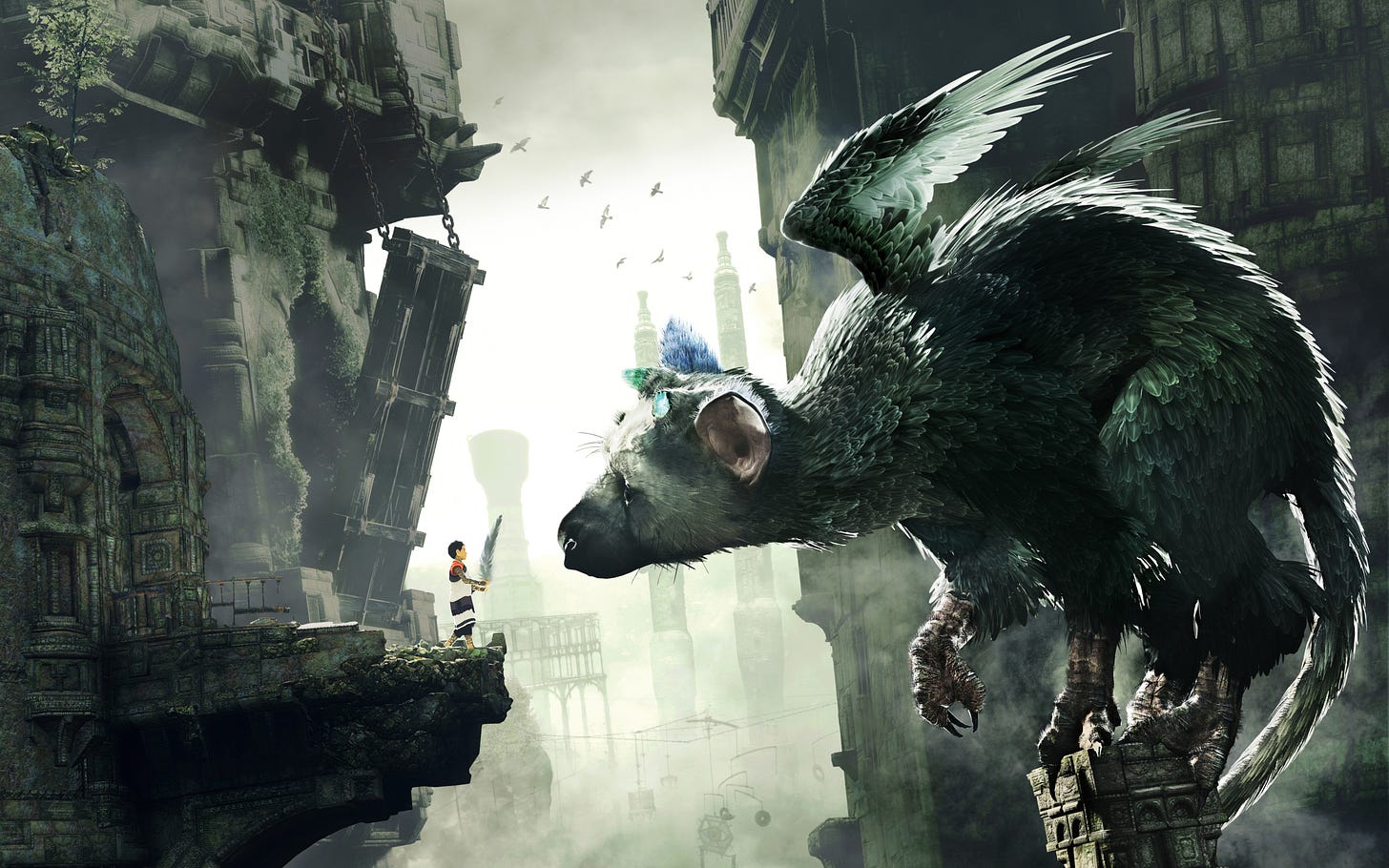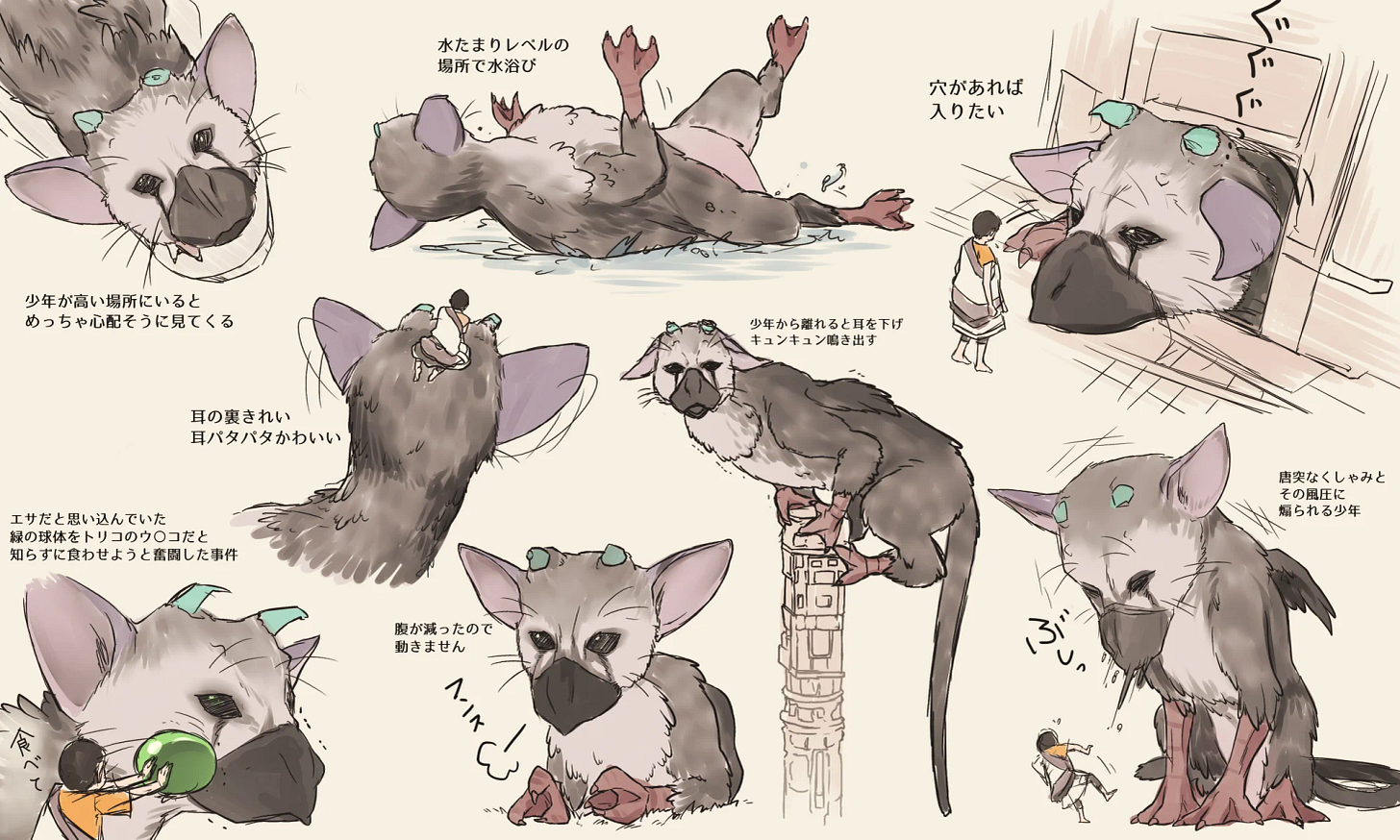Trico in The Last Guardian: A Masterclass in AI and Animation
In loving memory of Mars
The Last Guardian’s Trico stands as a landmark achievement in artificial intelligence and procedural animation, redefining how virtual creatures can simulate lifelike behavior. Through a sophisticated interplay of reactive systems, environmental awareness, and intentional unpredictability, Trico transcends traditional non-player character (NPC) design to become something more: a digital being that feels genuinely alive. This paper explores the technical and philosophical foundations of Trico’s AI, analyzing how emergent behaviors and dynamic animation establish a new paradigm for believable digital lifeforms.
The Architecture of Emergent Behavior
Priority-Based Decision Making
At the heart of Trico’s AI lies a priority-driven interest system. Environmental objects are assigned dynamic priority values, prompting Trico to shift attention between stimuli—such as food barrels or the boy’s voice—based on context. His behavioral logic unfolds in three phases:
Interest Detection: Trico scans his environment, identifying targets through a set of predefined criteria (e.g., movement, edibility).
Pathfinding: He calculates optimal routes in real-time, navigating complex terrain using inverse kinematics (IK).
Action Execution: His interaction style changes with environmental constraints—nudging the boy for help in narrow corridors or freely consuming barrels in open space.
This structure allows for emergent behavior that isn’t hard-coded. For instance, Trico may abandon exploration to rescue the boy from danger, dynamically reprioritizing tasks in a way that mirrors real animal behavior—curious, reactive, and emotionally responsive.
Procedural Animation: The Illusion of Muscle and Mind
Inverse Kinematics and Terrain Adaptation
Trico’s movement is generated procedurally, not scripted. His skeletal rig uses IK to align limbs with uneven terrain, ensuring his feet land naturally on slopes, rubble, or ledges. This prevents the uncanny rigidity often found in pre-animated characters; instead, Trico’s gait subtly shifts with each step, evoking an organic sense of weight and physicality.
"Lion-Dance" Head Stabilization
To reinforce realism, the developers implemented a head stabilization technique inspired by large felines. This system simulates muscle tension in Trico’s neck, allowing him to fix his gaze on an object while the rest of his body moves independently. The result is expressive: head tilts, eye-tracking, and subtle gestures that suggest cognition and curiosity.
Emotional Resonance Through Reactive Systems
Behavioral Idiosyncrasies
Trico’s design embraces deliberate imperfection to create lifelike unpredictability. He may yawn, scratch, sniff objects, or ignore the player to indulge in curiosity. These behaviors are governed by hidden states such as “fatigue” and “boredom”, creating the illusion of interiority—of a creature with its own agenda, not a predictable tool.
Dynamic Bonding Mechanics
Calling Trico with R1 is not a guaranteed action. His response is determined probabilistically, factoring in:
Distance: Far-off calls are less likely to succeed.
Obstruction: Barriers like glass eyes or walls hinder his pathfinding.
Mood: Post-combat distress may reduce responsiveness.
This design fosters a relationship, not a command system. As trust builds through shared experiences, Trico becomes more responsive—encouraging emotional investment from the player.
The Tension Between Realism and Playability
Intentional Frustration as Narrative Device
Critics have often cited Trico’s delayed obedience as frustrating, yet this is a deliberate choice. Director Fumito Ueda resisted designing a "perfect pet" AI, preferring a creature that feels willful and independent. Just like a real animal, Trico is distractible and emotionally variable. His hesitation emphasizes his aliveness, reinforcing the sense of cohabiting a world with a sentient other.
Subtle Player Guidance
To balance realism with playability, developers included supportive mechanics:
Camera Focus (L1): Pressing L1 subtly redirects Trico’s gaze toward relevant objects.
Boy’s Hints: The player character vocalizes contextual prompts (“Maybe Trico can reach that!”).
Fail-Safes: In critical moments—like enemy encounters—Trico will always respond to R1 presses, preserving narrative continuity and player safety.
Comparative Analysis: Trico vs. Contemporary Game AI
Beyond Elizabeth (BioShock Infinite)
While BioShock Infinite’s Elizabeth seamlessly avoids danger through scripted logic, Trico operates through real-time, unscripted AI. He can fail—getting stuck, misstepping, or hesitating—and these "failures" add realism, making him feel autonomous rather than choreographed.
Contrasting Horizon Zero Dawn
Horizon’s machines execute predictable attack patterns, tightly tied to combat design. Trico, in contrast, performs behaviors with no mechanical utility: preening, napping, sniffing. These non-goal-oriented actions enhance his believability, presenting him as a living creature, not a game object.
Philosophical Implications: What Makes a Creature "Alive"?
Trico invites reconsideration of how we define lifelike AI. His behavior is not humanlike but animalistic, driven by a blend of instinct, emotion, and sensory feedback.
Curiosity Over Utility: He investigates flickering shadows or ambient sounds with no in-game reward.
Emotional Contagion: He shivers when wet or distressed—animations the boy can mirror, encouraging empathy.
Imperfect Memory: He may “forget” solutions to previously solved puzzles if revisited, simulating fallible memory.
This approach reflects Ueda’s philosophy: "We wanted players to feel they were cooperating with a creature, not controlling one." Trico is not a pet, tool, or sidekick—but a cohabitant, shaped by the player's actions yet emotionally independent.
Technical Limitations and Ethical Considerations
Computational Demands
Trico’s AI required bespoke solutions:
Hierarchical Task Networks (HTNs): Complex behaviors like "eat barrel" are decomposed into subtasks: approach → sniff → bite.
Animation Blending: Over 1,200 motion-captured clips are stitched with procedural IK, allowing seamless transitions between reactive states.
These systems, while groundbreaking, contributed to long development cycles and performance issues such as frame rate drops.
Ethical AI Design
Trico challenges the industry to rethink player control. Should designers prioritize authenticity over obedience? The Last Guardian suggests a middle ground—AI that simulates autonomy while embedding invisible support systems to maintain engagement and narrative flow.
Conclusion: Redefining Lifelike AI
Trico represents a watershed moment in digital creature design. His “aliveness” doesn’t stem from graphical fidelity, but from procedural unpredictability, emotional nuance, and behavioral depth. By marrying technical complexity with narrative empathy, The Last Guardian offers a unique meditation on companionship, agency, and trust.
Future AI design can draw from its lessons:
Embrace Controlled Chaos: Unpredictability enhances realism and emotional engagement.
Design for Feedback: Every action should create ripples that impact player perception.
Allow for Failure: Organic, believable characters must sometimes falter.
Trico endures not because he’s perfect—but because he feels real.




